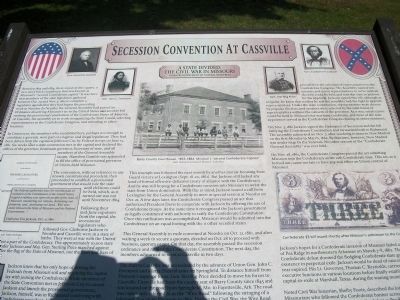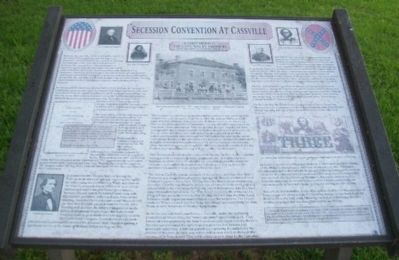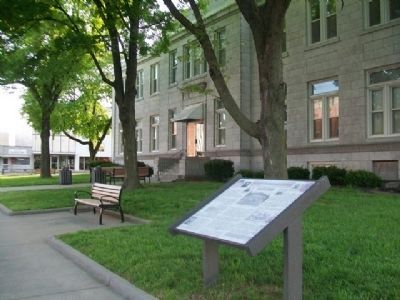Cassville in Barry County, Missouri — The American Midwest (Upper Plains)
Secession Convention in Cassville
A State Divided
— The Civil War in Missouri —
Inscription.
Between 1855 and 1884, there stood on this square, a two-story brick courthouse that was known as Missouri's "second Confederate capitol." It was here that members of the state legislature gathered between Oct. 29 and Nov. 7, 1861 to complete a legislative agenda that they had begun the preceding week at Neosho. In Neosho, the General Assembly had passed an Ordnance dissolving Missouri's tie to the United States and another bill ratifying the provisional constitution of the Confederate States of America. At Cassville, the assembly set to work reorganizing the State Guard, selecting representatives to the Confederate Congress, and attending to other business.
In Union eyes, the members who assembled here, perhaps not enough to constitute a quorum, were part of a fugitive and illegal legislature. They had been driven from the capital at Jefferson City by Federal troops on June 15, 1861. Six weeks later a state convention met in the capital and declared the offices of the governor, lieutenant governor, Secretary of State, and all members of the General Assembly vacant. Hamilton Gamble was appointed to fill the office of provisional governor of Union-held Missouri.
The convention, without reference to any known constitutional precedent, then proceeded to establish a provisional government that would rule the state until elections could be held, which, as it turned out was not until November 1864.
Following their mid-June expulsion from the capital, the secessionist legislators who followed Gov. Claiborne Jackson to Neosho and Cassville were in a state of limbo. They were at war with the United States but not yet a part of the Confederacy. The approximately 10,000 state guard troops under Jackson and Major General Sterling Price marched against the Yankees under a flag of the State of Missouri, not the Stars and Bars of the Confederacy.
Jackson knew that his only hope of driving the Federals from Missouri soil and regaining the capital lay with joining the Confederacy. While members of the State Convention met in Jefferson City to unseat Jackson and launch the provisional government, Jackson, himself, was in Richmond conferring with Confederate president, Jefferson Davis. Prior to this meeting, Jefferson Davis had been reluctant to aid Missouri until the state formally seeded from the Union. After meeting with Jackson, he softened his position to the extent of promising money to pay the State Guard troops as soon as such funds could be appropriated by the Confederate Congress. Confederate troops from Arkansas and Louisiana also assisted the Missouri State Guard in gaining a significant victory at the Battle of Wilson's Creek on August 10, 1861.
This triumph was followed the next month by another morale boosting State Guard victory at Lexington (September 18-20, 1861). But Jackson still lacked any kind of formal offensive-defensive treaty of alliance with the Confederacy. And he was still hoping for a Confederate invasion into Missouri to wrest the state from Union domination. With this in mind, Jackson issued a call from Lexington for the General Assembly to meet in special session at Neosho on October 21. A few days later, the Confederate Congress passed an act that authorized President Davis to cooperate with Jackson by offering the use of Confederate troops. At the same time it recognized the Jackson government as legally constituted with authority to ratify the Confederate Constitution. Once this ratification was accomplished, Missouri would be admitted into the Confederacy on an equal footing with the eleven other seceded states.
This General Assembly in exile convened at Neosho on October 21, 1861, and after waiting a week to secure a quorum, decided on October 28 to proceed with business, quorum or not. On that day, the assembly passed the secession ordinance and ratified the Confederate Constitution. The next day, the members adjourned to meet at Cassville two days hence.
The shift to Cassville was necessitated by the advance of Union General John C. Fremont and a large Federal army on Springfield. To distance himself from Fremont's superior force, Gen. Sterling Price decided to move his forces to Cassville. Cassville had been the county seat of Barry County since 1845 and was located in the road from Springfield, Missouri, to Fayetteville, Arkansas, which was commonly referred to as the "Wire Road" following the stringing of a telegraph line along the route in 1860. During the Civil War, the Wire Road became a vitally important transportation route for both sides. The bloody battles at Wilson's Creek and Pea Ridge were fought at points along the Wire Road, as were hundreds of smaller engagements.
In the six-year-old brick courthouse in Cassville, under the sheltering protection of Price's army, the "rebel legislature" again set to work. They passed an act reorganizing the State Guard and created ten military districts. Another confirmed the eight brigadier generals that Jackson had previously appointed. A bill was passed appropriating 10 million dollars for the defense of the state; Governor Jackson was authorized to raise this sum through the issuance of defense bonds.
One controversial action taken by the legislature provided for the selection or representatives to the Confederate Congress. The assembly named two senators and seven representatives to serve until an election could be held and sent this slate to Jackson for his approval. Jackson signed the bill although, as a legalist, he knew that neither he nor the assembly had the right to appoint representatives. Under the state constitution, representatives were chosen by popular election, and senators were selected by the House of Representatives without the consent of the governor. As it was, no election could be held in Missouri due to wartime conditions, and most of the nine appointees served in the Confederate Congress during its entire existence.
On November 3, 1861 Governor Jackson signed the Ordinance of Secession and the bill ratifying the Confederate Constitution and forwarded both to Richmond. The assembly adjourned on November 7, after resolving to meet in New Madrid on the first Monday in March, 1862. By that time, however, New Madrid was under siege by the Federals. No other session of the "Confederate General Assembly," was ever held.
On November 28, 1861, the Confederate Congress passed the act admitting Missouri into the Confederacy as the twelfth Confederate state. This act, as it turned out, came to late to have any real effect on Union control of Missouri.
Governor Jackson's hopes for a Confederate invasion of Missouri faded at the Battle of Pea Ridge in northwestern Arkansas on March 7-8, 1862. This major Confederate defeat doomed the fledgling Confederate state government to existence in perpetual exile. Governor Jackson would be dead of cancer before the year expired. His Lieutenant Governor, Thomas C. Reynolds, carried on the executive functions in various locations before finally establishing his capital-in-exile at Marshall, Texas, during the waning months of 1863.
Noted Civil War historian, Shelby Foote, described the lot of some 40,000 Missourians who followed the Confederate banner across battlefields far from home in the long years following the defeat at Pea Ridge that had secured a ravaged and war-torn Missouri for the Union:
"...Guerrilla bands might rip and tear [Missouri]... raider columns of various strengths might cut swaths of destruction up and down [the state], but...[Missouri's] star in the Confederate flag, placed there like Kentucky's by a fleeing secessionist legislature, represented nothing more from now on than the exiles who bore arms beneath that banner."
Erected 1997.
Topics and series. This historical marker is listed in this topic list: War, US Civil. In addition, it is included in the Missouri - A State Divided: The Civil War in Missouri series list. A significant historical month for this entry is March 1862.
Location. 36° 40.746′ N, 93° 52.089′ W. Marker is in Cassville, Missouri, in Barry County. Marker is on Main Street. On the Cassville, Missouri Courthouse lawn, between W. 7th and 8th Streets. Touch for map. Marker is in this post office area: Cassville MO 65625, United States of America. Touch for directions.
Other nearby markers. At least 8 other markers are within 16 miles of this marker, measured as the crow flies. Butterfield Overland Mail in Missouri - 1858-1861 (within shouting distance of this marker); Veterans Memorial (approx. half a mile away); Roaring River School (approx. 6.7 miles away); Douglas A-4 Skyhawk (approx. 9.9 miles away); a different marker also named Veterans Memorial (approx. 9.9 miles away); Purdy Veteran's Memorial (approx. 9.9 miles away); Potts' Hill (approx. 15.2 miles away in Arkansas); Butterfield Overland Mail in Missouri — 1858-1861 (approx. 15˝ miles away). Touch for a list and map of all markers in Cassville.
More about this marker. An excerpt from the Journal of the Senate, Extra Session of the Rebel Legislature, called together by a Proclamation of C. F. Jackson is included on the left side of the marker. It reads:
"...the Federal authorities have for months past in violation of the Constitution of the United States, waged a ruthless war upon the people of the State of Missouri, murdering our citizens, destroying our property, and...desolating our land... War now exists between the State of Missouri and the Federal Government..."
Claiborne Fox Jackson, October 21, 1861.
Regarding Secession Convention in Cassville. This tells Cassville, Missouri's history of the Civil War.
Also see . . . Barry County MO in the Civil War. (Submitted on January 9, 2015, by William Fischer, Jr. of Scranton, Pennsylvania.)
Credits. This page was last revised on March 22, 2023. It was originally submitted on July 14, 2011, by Nathan of Exeter, Missouri. This page has been viewed 1,205 times since then and 36 times this year. Photos: 1. submitted on July 14, 2011, by Nathan of Exeter, Missouri. 2, 3. submitted on January 9, 2015, by William Fischer, Jr. of Scranton, Pennsylvania. • Bill Pfingsten was the editor who published this page.


